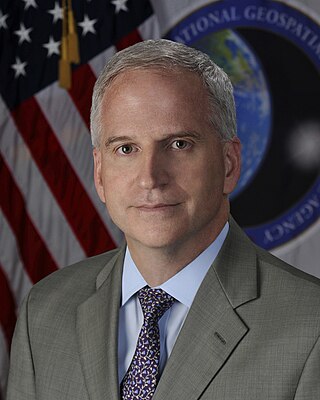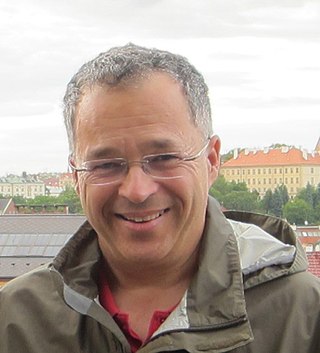Bracketology is the process of predicting the field of college basketball participants in the NCAA men's and women's basketball tournaments, named as such because it is commonly used to fill in tournament brackets for the postseason. It incorporates some method of predicting the metrics the NCAA Selection Committee will use in order to determine at-large teams to complete the field of 68 teams, and, to seed the field by ranking all teams from first through sixty-eighth. Bracketology also encompasses the process of predicting the winners of each of the brackets. In recent years the concept of bracketology has been applied to areas other than basketball.
Geovisualization or geovisualisation, also known as cartographic visualization, refers to a set of tools and techniques supporting the analysis of geospatial data through the use of interactive visualization.

Spatial analysis is any of the formal techniques which studies entities using their topological, geometric, or geographic properties. Spatial analysis includes a variety of techniques using different analytic approaches, especially spatial statistics. It may be applied in fields as diverse as astronomy, with its studies of the placement of galaxies in the cosmos, or to chip fabrication engineering, with its use of "place and route" algorithms to build complex wiring structures. In a more restricted sense, spatial analysis is geospatial analysis, the technique applied to structures at the human scale, most notably in the analysis of geographic data. It may also be applied to genomics, as in transcriptomics data.
Nonparametric regression is a category of regression analysis in which the predictor does not take a predetermined form but is constructed according to information derived from the data. That is, no parametric form is assumed for the relationship between predictors and dependent variable. Nonparametric regression requires larger sample sizes than regression based on parametric models because the data must supply the model structure as well as the model estimates.
Nils Lid Hjort is a Norwegian statistician, who has been a professor of mathematical statistics at the University of Oslo since 1991. Hjort's research themes are varied, with particularly noteworthy contributions in the fields of Bayesian probability, density estimation and nonparametric regression, model selection, confidence distributions, and change detection. He has also worked with spatial statistics, statistics of remote sensing, pattern recognition, etc.
Dynamic network analysis (DNA) is an emergent scientific field that brings together traditional social network analysis (SNA), link analysis (LA), social simulation and multi-agent systems (MAS) within network science and network theory. Dynamic networks are a function of time to a set of graphs; for each time point there is a graph. This is akin to the definition of dynamical systems, in which the function is from time to an ambient space, where instead of ambient space time is translated to relationships between pairs of vertices.

Peter Baumann is a German computer scientist and professor at Constructor University, Bremen, Germany, where he is head of the Large-Scale Scientific Information Systems research group in the Department of Computer Science and Electrical Engineering.

Jayanta Kumar Ghosh was an Indian statistician, an emeritus professor at Indian Statistical Institute and a professor of statistics at Purdue University.
March Madness pools are a form of sports betting based on the annual NCAA Division I men's basketball tournament each spring in the United States. The annual tournament bracket can be completed online or printed out and completed by hand whereby, prior to the tournament, participants predict the outcome of each tournament game. Each participant's predictions are compared against the others in a given pool. Various scoring systems exist to award points for correct predictions, and various alternative games related to March Madness predictions exist. Tens of millions of brackets are filled out each year. Due to the size of the tournament and its proclivity for upsets, a perfect bracket has never been achieved.

Robert Cardillo is a Distinguished Fellow at Georgetown University’s Center for Security and Emerging Technology. Prior to this appointment, he was the sixth Director of the National Geospatial-Intelligence Agency and was sworn in October 3, 2014. He was previously selected by Director of National Intelligence James Clapper to serve as the first Deputy Director of National Intelligence for Intelligence Integration in September 2010. Clapper said in a statement that the position would "elevate information sharing and collaboration" between those who collect intelligence and those who analyze it. Cardillo previously served as deputy director of the Defense Intelligence Agency (DIA). Prior to that, he served as the deputy director for Analysis, DIA, and Director, Analysis and Production, National Geospatial-Intelligence Agency (NGA).
Raymond James Carroll is an American statistician, and Distinguished Professor of statistics, nutrition and toxicology at Texas A&M University. He is a recipient of 1988 COPSS Presidents' Award and 2002 R. A. Fisher Lectureship. He has made fundamental contributions to measurement error model, nonparametric and semiparametric modeling.

Christian Genest is a professor in the Department of Mathematics and Statistics at McGill University, where he holds a Canada Research Chair. He is the author of numerous research papers in multivariate analysis, nonparametric statistics, extreme-value theory, and multiple-criteria decision analysis.

Adam James Clark is an American meteorologist at the Cooperative Institute for Mesoscale Meteorological Studies (CIMMS) and the National Severe Storms Laboratory (NSSL) recognized for contributions to numerical modeling of convection.
Noel Andrew Cressie is an Australian and American statistician. He is Distinguished Professor and Director, Centre for Environmental Informatics, at the University of Wollongong in Wollongong, Australia.
Yulia R. Gel is a professor in the Department of Mathematical Sciences at the University of Texas at Dallas and an adjunct professor in the Department of Statistics and Actuarial Science of the University of Waterloo.

The Geospatial Research Laboratory is a component of the Engineer Research and Development Center (ERDC), a US Army Corps of Engineers (USACE) laboratory organization whose mission is to "Provide science, technology, and expertise in engineering and environmental sciences in support of our Armed Forces and the Nation to make the world safer and better." The laboratory is colocated with the Army Geospatial Center in the Humphreys Engineer Center adjacent to Fort Belvoir. The headquarters is located in Vicksburg, Mississippi, on the site of an antecedent organization, the Waterways Experiment Station. GRL conducts geospatial research, development, technology and evaluation of current and emerging geospatial technologies that will help characterize and measure phenomena within the physical (terrain) and social (cultural) environments encountered by the Army.
Alan Enoch Gelfand is an American statistician, and is currently the James B. Duke Professor of Statistics and Decision Sciences at Duke University. Gelfand’s research includes substantial contributions to the fields of Bayesian statistics, spatial statistics and hierarchical modeling.
Xiaohong Chen is a Chinese economist who currently serves as the Malcolm K. Brachman Professor of Economics at Yale University. She is a fellow of the Econometric Society and a laureate of the China Economics Prize. As one of the leading experts in econometrics, her research focuses on econometric theory, Semi/nonparametric estimation and inference methods, Sieve methods, Nonlinear time series, and Semi/nonparametric models. She was elected to the American Academy of Arts and Sciences in 2019.

Stacey Angela Dixon is an American mechanical engineer and intelligence official and Principal Deputy Director of National Intelligence in the Biden Administration since August 4, 2021.

Jorge Mateu is a Spanish mathematician, author, and academic. He is a professor of Statistics within the Department of Mathematics at University Jaume I of Castellon and Director of the Unit Eurocop for Data Science in criminal activities in the same department.









